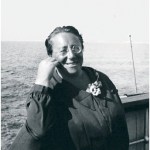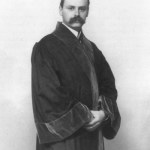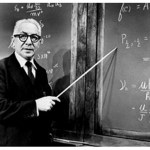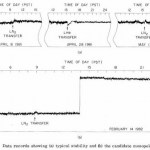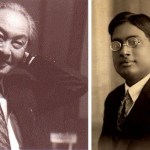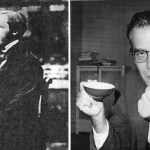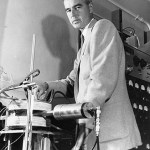Theory
A long-ish stretch of time, but I was basically offline for a bunch of that because I needed to finish a chapter I was asked to contribute to an academic book. So there are only four physics posts from Forbes to promote this time:
-- 'The Expanse' Is A Rare Sci-Fi Show That Gets Simulated Gravity Right: Another post on the SyFy adaptation of "James S. A. Corey"'s books, talking about a nifty bit of visual effects that nods at the Coriolis force you'd see on a rotating space station.
-- What Is The Quantum Pigeonhole Principle And Why Is It Weird?: A paper published in the Proceedings of the…
I've been slacking in my obligation to use this blog for self-promotion, but every now and then I remember, so here are two recent things where I was interviewed by other people:
-- I spoke on the phone to a reporter from Popular Mechanics who was writing a story about "radionics" and "wishing boxes," a particular variety of pseudoscience sometimes justified with references to quantum mechanics. The resulting story is now up, and quotes me:
It is hard to investigate the ethereal thinking around radionics, but physics is something that can be parsed. So I got in touch with Chad Orzel, a…
There's a new Science Express paper on interfering clocks today, which is written up in Physics World, with comments from yours truly. The quote is from a much longer message I sent-- with no expectation that it would end up as anything other than a pull quote, I might add, but I thought the background would be helpful. Since I ended up doing a back-of-the-envelope estimate for that, though, I thought I would reproduce some of the reasoning here.
The basic proposal idea here is to do an atom interferometer inside a Ramsey interferometer for making an atomic clock. That is, before sending the…
I spent the last few days in Ontario, attending the Convergence meeting at the Perimeter Institute. This brought a bunch of Perimeter alumni and other big names together for a series of talks and discussions about the current state and future course of physics.
My role at this was basically to impersonate a journalist, and I had a MEDIA credential to prove it. I did a series of posts at Forbes about different aspects of the meeting:
-- The Laser Cavity was Flooded: a revisiting of the idea of True Lab Stories, which was a loose series of funny disaster tales from the early days of…
I was proctoring an exam yesterday in two different sections of the same class, so I had a lot of quite time. Which means I wrote not one but two new posts for Forbes...
The first continues a loose series of posts about the exotic physics behind everyday objects (something I'm toying with as a possible theme for a new book...), looking at the surprisingly complicated physics of an incandescent light bulb. A light bulb filament emits (to a reasonable approximation) black-body radiation, which is historically important as the starting point for quantum physics. But when you think about it, it's…
I've been sort of falling down on my obligation to promote myself-- I've written two blog posts for Forbes this week, and forgotten to post about them here. The first is a thing about philosophy in physics, and how Einstein illustrates both the good and bad aspects of a philosophical approach.
The second is a bit on the listicle side, looking at some types of diagrams that physicists draw when talking about physics. It's prompted by a ZapperZ post noting that scientists talking about science always draw pictures, but other subjects get by with just talking.
These are both quickly-dashed-off…
The editor at Forbes suggested I should write something about the re-start of the Large Hadron Collider, so I did. But being me, I couldn't just do an "LHC, yay!" post, but talk about it in a larger context, as one of three major approaches to filling the gaps in the Standard Model:
The big physics story over the weekend was the re-start of the Large Hadron Collider at CERN, the world’s largest and highest-energy particle accelerator. It was initially started in 2008, but some key circuits failed shortly after it was switched on. A relatively quick patch job allowed it to operate at half its…
Two roads diverged in a yellow wood, And caused me no small amount of panic For traveling both of them would be good But there simply was no way I could Until I remembered quantum mechanics.
So half my wavefunction I sent left And rightward steered the other half Both pieces of me with equal heft And thanks to calculations deft, I knew the end would sum both paths
Plenty of physicists claim to know Or at least will confidently speculateThat collapse, or a pilot wave's flow, Or decoherence act to make it so. Me, I just shut up and calculate.
So in the woods I went two ways To return together…
There have been some good comments on last week's post about the Many-Worlds Interpretation, which I find a little surprising, as it was thrown together very quickly and kind of rant-y on my part, because I was annoyed by the tone of the original Phillip Ball article. (His follow-up hasn't helped that...) But then maybe that's why it succeeded in generating good comments. Tough call.
Anyway, I let these slide for a while because of day-job stuff, so I'm going to promote this to a new post, and try to address some of these. Because, apparently, we are never out of universes in which I'm…
Phillip Ball has a long aggrieved essay about the Many-Worlds Interpretation, which is, as Sean Carroll notes, pretty bad. Ball declares that Many-Worlds is "incoherent, both philosophically and logically," but in fact, he's got this exactly backwards: Many-Worlds is, in fact, a marvel of logical and philosophical coherence, while Ball's objections are incoherent and illogical.
The fundamental problem with Many-Worlds is that every argument about it devolves very quickly into stoner dorm-room bull session nonsense about parallel worlds and identity and morality. But none of that is physics.…
(When I launched the Advent Calendar of Science Stories series back in December, I had a few things in mind, but wasn’t sure I’d get through 24 days. In the end, I had more than enough material, and in fact didn’t end up using a few of my original ideas. So I’ll do a few additional posts, on an occasional basis, to use up a bit more of the leftover bits from Eureka: Discovering Your Inner Scientist…)
While Eureka is built around stories, it's really a book about the process of science, using those stories to highlight particular aspects of the scientific process. The hope is that making the…
(When I launched the Advent Calendar of Science Stories series back in December, I had a few things in mind, but wasn’t sure I’d get through 24 days. In the end, I had more than enough material, and in fact didn’t end up using a few of my original ideas. So I’ll do a few additional posts, on an occasional basis, to use up a bit more of the leftover bits from Eureka: Discovering Your Inner Scientist…)
While we mostly think of science being done in comfortable institutes if not gleaming laboratories, one of the most impressive and inspiring things about science is that people can and do carry…
Over at Curious Wavefunction, Ashutosh Jogalekar offers a list of great surprising results in physics. This is fairly comprehensive, but leaves out one of my favorites, which is the discovery of the muon. Muons are particles like electrons, but a couple hundred times heavier. When they were first detected in cosmic ray traces in 1936, physicists briefly thought they were the mesons that Hideki Yukawa had predicted as the carriers of the strong nuclear force. It quickly became clear, though, that while the mass was about right to be Yukawa's particle, the muon didn't have anything to do with…
(When I launched the Advent Calendar of Science Stories series back in December, I had a few things in mind, but wasn't sure I'd get through 24 days. In the end, I had more than enough material, and in fact didn't end up using a few of my original ideas. So I'll do a few additional posts, on an occasional basis, to use up a bit more of the leftover bits from Eureka: Discovering Your Inner Scientist...)
One of the tricky things about writing this book was that I didn't just need stories from the history of science, but stories that fit a particular pattern. The point of the book, after all, is…
(That title doesn't quite scan as is, but if you stick an "a" in there, you can sing it to the tune of a song from "Fiddler on the Roof"... You're welcome.)
The last time I taught my "Brief History of Timekeeping" seminar was in 2012, so I spent a bunch of time on the Mayan calendar. This time around, we've lost the obvious pop-culture hook, but it's still so weird and fascinating that I spent a class on it last week. One of the things we talked about was what this system (what we know of it) says about the Maya concept of time. There's a very obvious contrast between the interlocking…
(When I launched the Advent Calendar of Science Stories series back in December, I had a few things in mind, but wasn't sure I'd get through 24 days. In the end, I had more than enough material, and in fact didn't end up using a few of my original ideas. So I'll do a few additional posts, on an occasional basis, to use up a bit more of the leftover bits from Eureka: Discovering Your Inner Scientist...)
Every physicist with the tiniest bit of a public profile gets letters from people with a pet theory to promote. These days, email and social media make it incredibly easy to flood the inbox of…
(When I launched the Advent Calendar of Science Stories series back in December, I had a few things in mind, but wasn't sure I'd get through 24 days. In the end, I had more than enough material, and in fact didn't end up using a few of my original ideas. So I'll do a few additional posts, on an occasional basis, to use up a bit more of the leftover bits from Eureka: Discovering Your Inner Scientist...)
One of my very favorite stories about a famous physicist concerns a young man of about 19, arriving at Cambridge from the University of Edinburgh. While being introduced around the college, it…
One of the very best books I ran across in the process of doing research for Eureka is The Second Creation: Makers of the Revolution in Twentieth-Century Physics by Robert P. Crease and Charles C. Mann. It's an extremely detailed treatment of the development of quantum theory, and includes anecdotes that I haven't seen elsewhere. It also does a fantastic job of showing the essential interplay of experiment and theory through the difficult process of developing quantum field theory, which is often underplayed in popular treatments (which tend to be written by theorists, and often treat…
Given that I am relentlessly flogging a book about the universality of the scientific process (Available wherever books are sold! They make excellent winter solstice holiday gifts!), I feel like I ought to try to say something about the latest kerfuffle about the scientific method. This takes the form of an editorial in Nature complaining that Richard Dawid and Sean Carroll among others are calling for discarding traditional ideas about how to test theories. Which is cast as an attempt to overthrow The Scientific Method.
Which, you know, on the one hand is a kind of impossible claim. There…
Back in August, I gave a talk in Stockholm at the Nordita workshop for science writers, about precision measurement searches for physics beyond the Standard Model. There's now video of this online:
The video quality isn't great, but if you'd like a clearer look at the slides, I've posted them on SlideShare. The talk was divided into two parts, though the video is not:
Part 1:
High Precision, Not High Energy: Using Atomic Physics to Look Beyond the Standard Model (Part I) from Chad Orzel
Part 2:
High Precision, Not High Energy: Using Atomic Physics to Look Beyond the Standard Model (…

